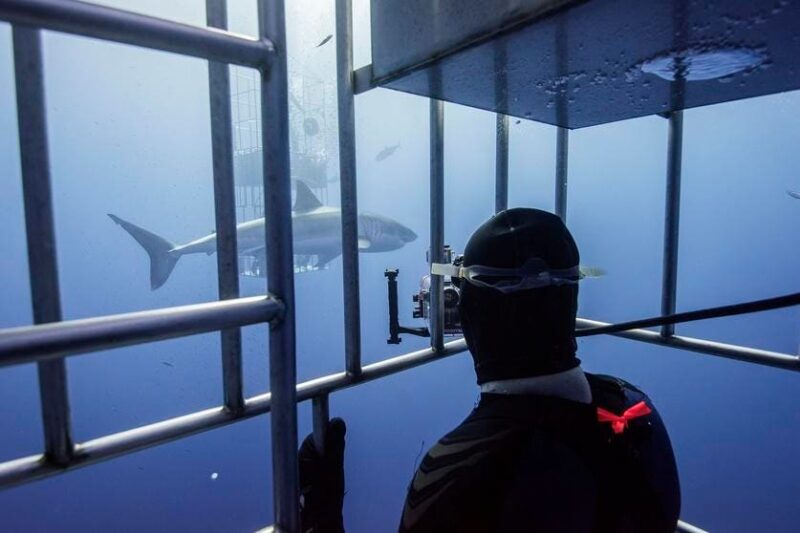Shark provisioning for tourism is often controversial, but it has created unique opportunities for scientific research.
getty
Studying large, predatory sharks in the wild has always been one of the most challenging areas of marine biology. While these animals are… well, large, the ocean is larger. Not to mention that many species travel long distances, occupy remote parts of the ocean, and avoid human interaction, making traditional (often invasive) research methods difficult. Most of what we know about sharks comes from catch-and-release studies, observations of captive individuals, or other limited approaches that cannot capture the complexity of their behavior or ecology. Today, nearly 70 percent of oceanic sharks and rays and 59 percent of reef-associated species are threatened with extinction, and almost all elasmobranch species face some level of exploitation either directly or as bycatch. Persistent overfishing remains the most serious threat, alongside the demand for meat, fins, and bycatch mortality.
Given the challenges and the urgent need to protect these predators, it’s clear that we must explore every possible avenue to study these animals — even unconventional ones.
Non-lethal human interactions with sharks (such as tourism-based observations) have grown rapidly over the last few decades. Shark-diving tourism, often called shark ecotourism, allows snorkelers, freedivers, and scuba divers to observe sharks in their natural habitats, sometimes with baiting to increase sighting opportunities. And although shark provisioning is controversial and banned in some countries, it provides scientists with a rare chance to reliably and repeatedly observe certain species in the wild. A team of researchers recently set out to better understand how tourism-driven shark provisioning has contributed to scientific knowledge across multiple disciplines and to explore its potential role in future research.
They found that the benefits of shark-diving tourism for research are multifaceted. Access to repeated encounters with individual sharks has enabled scientists to study behavior, sociability, cognition, and population dynamics. For example, long-term photo-identification at Guadalupe Island revealed patterns of site fidelity and seasonal abundance for white sharks. In Fiji, repeated observations at feeding sites uncovered associations among bull sharks that may indicate non-random social behaviors. Even smaller reef-associated species, like blacktip reef sharks and sicklefin lemon sharks, have shown evidence of social choice, tolerance, and avoidance at provisioned sites, offering insights that would be nearly impossible to gather in the wild without tourism operators’ support. Tourist provisioning sites also serve as testing grounds for new research tools and methodologies; scientists have used dive operations to trial underwater ultrasonography to assess pregnancy in bull and tiger sharks, deploy acoustic and satellite tags with minimal risk, and evaluate shark-deterrent devices. Video and photographic monitoring, supported by tour operators, has also allowed researchers to track individual movements, analyze behavioral patterns, and even study interactions with non-target species like rays and smaller sharks. Opportunistic observations at these sites has even led to discoveries ranging from wound healing and pigmentation changes to predator-prey interactions that would be difficult to witness in more open, unpredictable environments.
By providing regular access to elusive shark species, shark tourism operations have allowed studies on behavior, sociability, cognition, and population dynamics that would otherwise be nearly impossible. When managed responsibly, such collaborations can support conservation, local economies, and our understanding of these threatened predators.
AFP via Getty Images
Economic and conservation outcomes are another significant advantage to this set up. In places like the Bahamas, Fiji, and Australia, shark-diving tourism contributes tens to hundreds of millions of dollars annually and has supported the creation of marine protected areas that safeguard sharks and other marine life in these areas while promoting stewardship values in the local communities. Positive human-shark interactions can also foster conservation awareness and engagement, which can influence policy and public perceptions of sharks, moving away from the outdated image of them as indiscriminate predators aka “mindless man-eating monsters.”
Yet, despite these benefits, there are risks. Provisioning can alter natural behaviors, energy budgets, and spatial patterns; it’s important to note that effects are species-dependent, with some sharks showing resilience to changes while others possibly expending energy with limited rewards. Ethical and ecological acceptability also depends on factors such as the species involved, geographic context, regulatory frameworks, and best practices in provisioning. So, the authors suggest that researchers working at feeding sites carefully design studies that account for these impacts while avoiding unintended ecological consequences.
Looking forward, the team believes that strong collaboration between scientists and tour operators can continue to yield valuable insights. Tourism has been proven to provide repeated access to large-bodied adult sharks that are nearly impossible to study in captivity or through conventional fieldwork! This sort of “partnership” allows for the exploration of individual differences, cognition, and social dynamics. These tourist hotspots also allow ample opportunities to test new, less invasive technologies and to collect long-term data that can inform conservation management. But at the same time, researchers must navigate potential conflicts of interest, including the misuse of science for marketing and the exploitation of early-career scientists, ensuring that ethical standards and scientific integrity guide all activities.
The history of shark research shows a clear pattern: tourism has often enabled scientific discovery in ways traditional methods cannot. By embracing careful, science-informed collaborations, shark-diving tourism has the potential to advance our understanding of these iconic predators, improve conservation outcomes, and shift public perception from fear to appreciation. To truly protect these animals, we need to think beyond traditional approaches and explore strategies we haven’t tried before. Only through collaboration between scientists, tourism operators, local communities, and policymakers can we create solutions that are both effective and sustainable, ensuring these remarkable predators thrive for generations to come.









